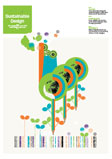Sustainable Design Supplement

The sustainability debate has grown more sophisticated of late. A sustainable approach should encompass social change as well as the environment and economy, and the debate is now about local wellbeing as much as it is about saving the planet.
The global economic crisis might have inadvertently got the ball rolling on social change, as Sophie Thomas of Thomas Matthews points out, with the demise of polluting industries making way for a more sustainable economic approach in some parts of the world.
At the same time, many global companies are moving beyond accusations of ’Greenwashing’ and making sense of the commercial equation offered by corporate strategies of sustainability. But is it too little, too late?
One area where design can play a vital role is in tackling planned obsolescence, particularly in electrical goods. Different approaches include design for disassembly, redesigning repairs and services, and products for life, but again, the main requirement is a change in social attitudes to counter the throwaway culture.
While some in design strive towards such lofty goals, all should honour the basics of sustainability and ensure best practice in sourcing materials, processes and suppliers. Making a project more environmentally friendly is often about balance – weighing up client and budget demands as well as design integrity. But with extensive resources available at the click of a mouse button, there is no excuse for not asking those questions.
Anna Richardson Supplement editor
-
Post a comment




